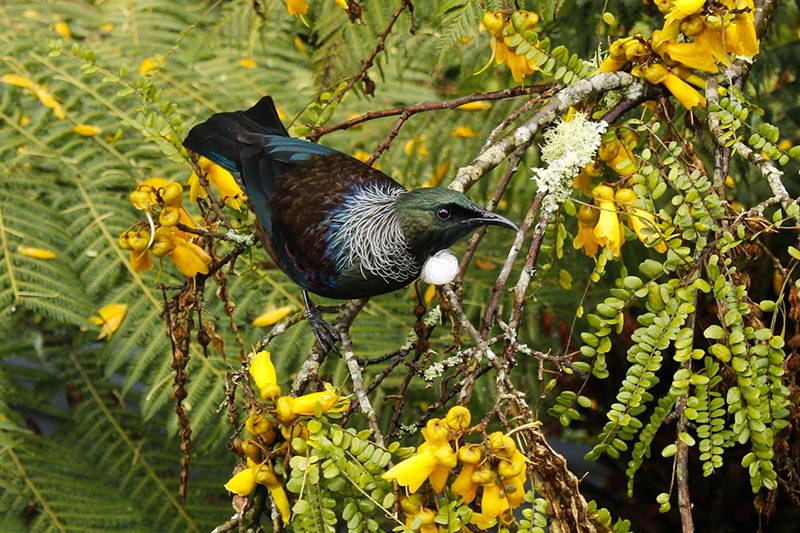Is this a focusing problem?
I don’t see this as a focusing problem. The problem is strong backlighting and the wrong metering mode. If you look a the photo the light is coming from behind the bird. The problem is that the side of the bird facing the camera is un-lit and there is very little detail visible. On the other hand, the tree is well lit and this creates a silhouette effect of the bird.
 Tūī (too EE) – Maryjane Hillier
Tūī (too EE) – Maryjane Hillier
Metering Modes
If you are trying to get a shot of a backlit subject, try changing the metering mode from Evaluative to Partial. Metering modes measure the amount of light on the focus point.
Evaluative metering is the default setting and evaluates a high percentage of the scene.
Partial metering works best when the background is much brighter than the subject.
Center-weighted metering is weighted at the center and then averaged over the whole scene.
Spot metering covers the area immediately around the focus point. Some newer models don’t have spot metering.
So Partial metering would have worked better for this photo as the backlight seems harsh.
Think about the available light
Whenever you are about to take a photo consider the available light and where it’s coming from. In most cases you want your subject to be well lit. So think about moving to a different spot to make full use of the available sunlight. If you are shooting in the late afternoon with the sun directly behind you check to see if your shadow is in the frame. If it is change your angle of attack. Don’t shoot humans with the sun directly in their faces, we squint our eyes. Animals don’t so make full use of the sun.
Cloudy, overcast days are a photographer’s best friend. The cloud covering acts as a diffuser and casts a very even light, which is great for portraits.
Supply your own light
In certain situations consider using a flash for fill light or a reflector to bounce the sunlight onto the subject. Unfortunately, wild animals don’t like hanging around when humans point cameras at them. So be strategic, plan ahead, and use the sun to your advantage.

Tūī (too EE) – Maryjane Hillier – Take 2 with correct metering and good lighting.
_______________________________________________________________________
Blurry Landscapes
If you are taking a photo of a landscape and they are a little blurry, my first guess would be you are hand-holding the camera. Landscape photography needs stability and lots of it.
You need two tools to give your camera a stable base. They are a solid tripod and a ball head to go on top of the tripod for the camera to be mounted to. Cheap tripods tend to have wobbly legs and can cause movement as the photo is taken. You could get away with a cheaper tripod/ball head if your camera/lens is lightweight and there is no wind when you’re using it. Do a little research before buying and consider buying a used quality tripod. Ball heads are also important. You need the ball head to be strong and stable. It’s no good having a stable tripod if the ball head isn’t.
The act of pushing the shutter button down can cause movement. So you can either use the self-timer set at 2 or more seconds. This lets you push the shutter button and there is a delay of 2 or more seconds before the image is taken. Or buy a remote shutter release that allows you to take the photo without pushing the shutter button.
Once you have a stable base your images will be sharp.
What Aperture should I use?
Landscapes are normally shot using apertures in the f/8 to f/18 range. The aim is to get everything in focus with a deep depth of field. Also, try to focus on something ⅓ to halfway into the scene. Don’t use multiple focus points, just one will do.
You’ll be amazed at the quality of your images when you use a tripod.
